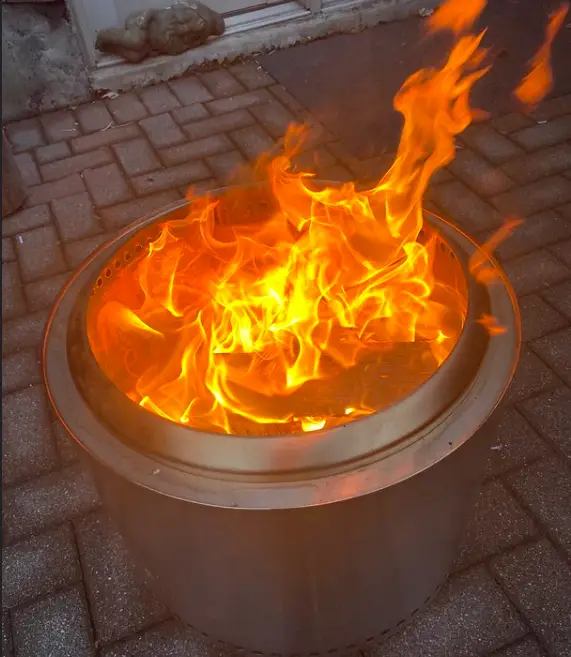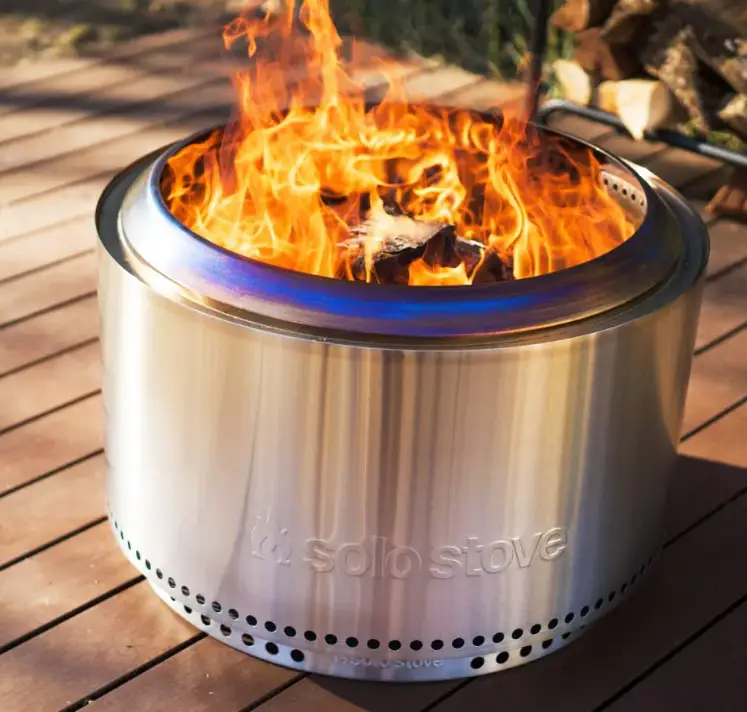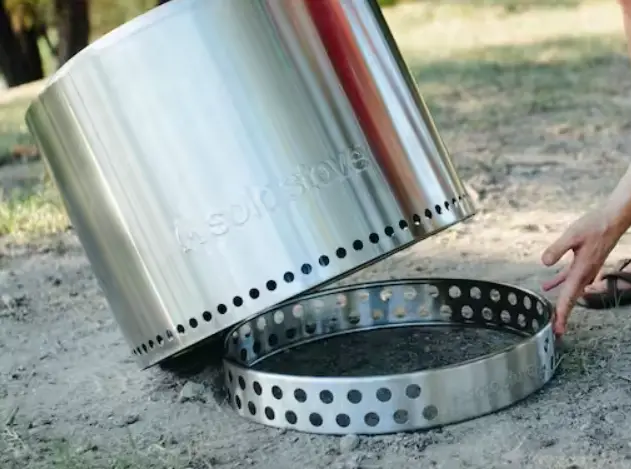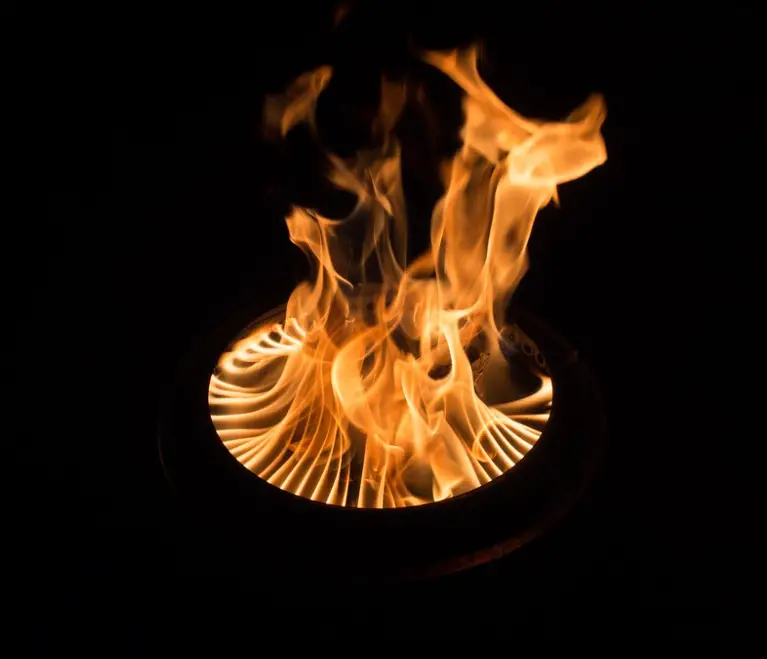If you’re a fan of outdoor gatherings and love to roast marshmallows or cook meals over a fire pit, you might be wondering if it’s safe to use a Solo Stove on your wood deck. Yes, it is safe to use a Solo Stove on a wood deck, as long as you use a stand.
While a Solo Stove emits less heat than other types of fire pits, it can still damage your deck without a heatproof barrier in place. A Solo Stove stand or fireproof mat is necessary to protect your deck from the heat and embers.
Key Takeaways
- A Solo Stove can be used on a wood deck with a stand or fireproof mat.
- Using a stand or mat is important to protect your deck from heat and embers.
- Safety precautions should be taken when using a Solo Stove on any surface.
Understanding Solo Stoves

If you’re looking for a portable and efficient wood-burning stove, Solo Stove is a great option. These stoves are designed to be used outdoors and are perfect for camping trips, backyard parties, or just enjoying a night under the stars.
Here’s what you need to know about Solo Stoves.
Materials
Solo Stoves are made from high-quality 304 stainless steel, which is both durable and rust-resistant. This type of steel is commonly used in kitchen appliances and is known for its strength and corrosion resistance. The 304 stainless steel used in Solo Stoves is also easy to clean and maintain.
Insulated Design
One of the standout features of Solo Stoves is their insulated design. The stoves are designed with double walls that create a barrier between the fire and the outside air. This helps to keep the fire burning hot and also reduces smoke and ash.
Bottom Vents
Solo Stoves also feature bottom vents that allow air to flow into the fire. This helps to keep the fire burning hot and also reduces smoke and ash. The vents can be adjusted to control the airflow and the intensity of the fire.
Using Solo Stoves on a Wood Deck
While Solo Stoves are safe to use on a wood deck, it’s important to use a stand to elevate the stove off the deck surface. This will help to prevent the deck from getting too hot and potentially catching fire. It’s also a good idea to place the stove on a fire-resistant surface, such as a metal or stone plate.
Using Solo Stove on Different Surfaces

When it comes to using a Solo Stove on different surfaces, it’s important to take into consideration the potential risks and precautions necessary to protect both your property and the environment. In this section, we’ll cover the different surfaces you may encounter and how to safely use your Solo Stove on each one.
Wood Decks
If you’re planning on using your Solo Stove on a wood deck, it’s essential to use a Solo Stove Stand and a heat-resistant barrier for a fire pit underneath it to protect the surface.
The Solo Stove will get extremely hot while burning, and for softer materials like untreated wood, it’s advisable to have additional protection.
It’s also important to make sure your wood deck is in good condition, free of any rot or damage, and not too close to any structures that could catch fire.
Composite Decking
Composite decking is made from a combination of wood fibers and plastic, which makes it more resistant to heat and fire than wood. You still need to take precautions when using a Solo Stove on a composite deck.
You can use a Solo Stove on a composite deck, but you should use a fire-resistant mat or pad underneath the stove to protect the surface. It’s also important to make sure your composite deck is in good condition and free of any damage.
Concrete and Other Hard Surfaces
Solo Stoves can be used on concrete and other hard surfaces without any additional protection. However, it’s important to make sure your Solo Stove is on a level surface and not too close to any structures that could catch fire.
If you’re using your Solo Stove on painted, stained, or stamped concrete, it’s advisable to use a heat-resistant barrier to protect the surface from discoloration or damage.
Grass and Natural Surfaces
If you’re using your Solo Stove on grass or other natural surfaces, it’s important to make sure the area is clear of any flammable materials, such as leaves or dry grass.
You should also use a heat-resistant barrier to protect the surface from discoloration or damage. If you’re using your Solo Stove on a beach, it’s important to make sure you’re not violating any local ordinances or regulations regarding open fires.
Importance of Using a Stand

If you’re planning on using a Solo Stove on your wood deck, it’s important to use a stand. A stand is a device that elevates your Solo Stove off the ground to prevent it from damaging your deck. Here are a few reasons why using a stand is so important:
Protects Your Deck
Wooden decks can be easily damaged by high temperatures. Untreated wood can ignite at 356° F, and even treated wood can be damaged by prolonged exposure to heat.
By using a Solo Stove stand, you can protect your deck from the high temperatures produced by your fire pit.
Prevents Accidents
Without a stand, your Solo Stove could easily tip over on your deck, causing a fire or other accidents. A sturdy stand will keep your fire pit stable and prevent it from falling over.
Made of High-Quality Materials
Solo Stove stands are made of 304 stainless steel, which is a durable and sturdy material that can withstand high temperatures. This means that your stand will last for years and provide reliable protection for your deck.
Easy to Use
Using a Solo Stove stand is incredibly easy. Simply place your fire pit on the stand, and you’re ready to go. The stand will keep your fire pit stable and prevent it from damaging your deck.
Safety Precautions When Using Solo Stove

If you’re planning to use your Solo Stove on a wood deck, there are some safety precautions you should take to ensure that you and your loved ones are safe while enjoying the warmth and coziness of your fire pit.
Heat-Resistant Barriers
It’s important to use a heat-resistant barrier between your Solo Stove and your wood deck. This barrier can be in the form of a fireproof mat, a fire-resistant mat, or a stand.
That extra layer will protect your deck from the heat generated by the fire pit and prevent any damage to the wood.
See Related: How Hot Does A Fire Pit Get?
Fire Guards and Spark Screens
Fire guards and spark screens are essential safety features that can help prevent accidents and injuries. They will prevent sparks and embers from flying out of the fire pit and onto your deck, reducing the risk of fire.
See Related: How To Keep A Fire Pit Going All Night
Keeping Solo Stove Clean
Keeping your Solo Stove clean is crucial to ensure that it’s functioning correctly and safely. After each use, make sure to remove any ash or debris from the fire pit. This will prevent any residual heat from igniting any flammable materials on your deck.
Safety Around Kids and Pets
It’s important to keep kids and pets away from the fire pit while it’s in use. Teach your children about fire safety and make sure they understand the dangers of playing with fire. Keep pets on a leash or in a confined area to prevent them from accidentally knocking over the fire pit or getting burned.
Remember, using a Solo Stove on a wood deck is safe as long as you take the necessary precautions. By following these safety tips, you can enjoy the warmth and ambiance of your fire pit without worrying about the risk of fire or injury.
See Related: How To Put Out A Solo Stove Fire
Solo Stove in Different Weather Conditions
Using your Solo Stove on a wood deck is a great way to enjoy the warmth and ambiance of a fire pit without leaving the comfort of your home. However, it’s important to consider the weather conditions before lighting up your Solo Stove.
Rain
If you’re planning on using your Solo Stove on a rainy day, it’s important to take some precautions to ensure that your deck stays dry.
One option is to move your Solo Stove to a covered area, such as a porch or gazebo. If you don’t have a covered area, you can use a waterproof cover to protect your Solo Stove from the rain.
Covered Deck
If you have a covered deck, you can use your Solo Stove without worrying about rain or other weather conditions. Make sure that your Solo Stove is placed on a stable and level surface. This will prevent it from tipping over and causing damage to your deck.
Other Weather Conditions
While rain and a covered deck are the most common weather conditions to consider when using your Solo Stove on a wood deck, there are other conditions to keep in mind as well. For example, if it’s very windy, you may need to use a wind guard to prevent the flames from blowing out of control.
Types of Solo Stove Fire Pits
When it comes to choosing a fire pit, Solo Stove offers a variety of options to fit your needs. Here are some of the types of Solo Stove fire pits:
Solo Stove Bonfire
The Solo Stove Bonfire is a popular choice for those looking for a smokeless fire pit. It is made of stainless steel and has a unique double-wall design that maximizes airflow and burns wood more efficiently.
The Bonfire can hold logs up to 16 inches long and is perfect for backyard gatherings or camping trips.
Solo Stove Ranger
The Solo Stove Ranger is the smallest fire pit in the Solo Stove lineup. It is portable and lightweight, making it perfect for camping or tailgating.
The Ranger can hold logs up to 12 inches long and has a unique airflow system that creates a smokeless fire.
Solo Stove Yukon
The Solo Stove Yukon is the largest fire pit in the Solo Stove lineup. It is designed for those who want a permanent fire pit in their backyard.
The Yukon can hold logs up to 24 inches long and has a unique airflow system that creates a smokeless fire. It is made of stainless steel and is built to last.
Duraflame Fire Pit
If you’re looking for a more traditional wood-burning fire pit, the Duraflame Fire Pit is a great option. It is made of steel and has a mesh screen to keep sparks from flying out. The Duraflame Fire Pit is perfect for backyard gatherings or camping trips.
Benefits and Drawbacks of Using Solo Stove
If you are someone who loves to spend time outdoors, then you know how important it is to have a fire pit that is safe and easy to use.
The Solo Stove is a popular choice because of its unique design that promotes airflow, creating a more efficient burn and less smoke.
Benefits
- Smokeless: The Solo Stove is designed to be smokeless, which means you won’t have to deal with eye-watering smoke while enjoying your fire pit. This is because the lack of oxygen and the rising hot air created by the fire pulls air through the bottom vents, bringing more oxygen into the fire pit. The air comes up through holes in the base of the pit, as well as through holes at the top.
- Efficient Burn: The Solo Stove promotes airflow, which creates a more efficient burn. This means that you will use less wood and get more heat from your fire pit, making it more cost-effective in the long run.
- Portable: The Solo Stove is lightweight and portable, which makes it easy to move from one location to another. This means you can take it with you on camping trips or to your friend’s backyard barbecue.
Drawbacks
- Heat Damage: The Solo Stove can produce a lot of heat, which can cause damage to your wood deck. To avoid this, you will need to purchase a stand that is specifically designed for the Solo Stove. This will elevate the fire pit off the deck and prevent heat damage.
- Sparks: The Solo Stove can produce sparks, which can be dangerous if they land on your wood deck. To prevent this, you should place a fireproof mat underneath the fire pit.
- Air Vents: The Solo Stove needs air to burn efficiently, which means you will need to make sure that the air vents are not blocked. This can be a problem if you place the fire pit too close to a wall or other obstruction.
Ultimately, the Solo Stove is a great choice for those who want a safe and efficient fire pit. However, if you plan to use it on a wood deck, you will need to purchase a stand and take precautions to prevent heat damage and sparks. With the right setup, you can enjoy a smokeless fire pit on your wood deck without any problems.
Choosing the Right Fuel for Solo Stove
When it comes to using a Solo Stove on a wood deck, safety is a top priority. But once you have the necessary precautions in place, it’s time to think about the type of fuel you want to use in your fire pit.
The Solo Stove is designed to burn a variety of fuels, including firewood, charcoal, and even recycled firewood logs. Not all fuels are created equal, and some may work better than others depending on your needs.
See Related: How To Start a Campfire
Firewood
Firewood is the most traditional fuel for a Solo Stove, and for good reason. It’s readily available, easy to use, and provides a classic campfire experience. When choosing firewood for your Solo Stove, it’s important to select dry, seasoned wood that has been cut to the appropriate size for your fire pit.
Hardwoods like birch, bradford pear, and hickory are all great options, as they burn hot and long. Other types of wood, like juniper and cedar, can also be used, but may not burn as efficiently.
See Related: 19 Types Of Wood You Shouldn’t Burn
Charcoal
If you’re looking for a fuel that burns hot and clean, charcoal is a great option for your Solo Stove. It’s easy to light and produces less smoke and ash than firewood.
When selecting charcoal for your fire pit, be sure to choose high-quality, all-natural lump charcoal, as briquettes can contain chemicals and additives that are not safe for cooking or burning.
Recycled Firewood Logs
Recycled firewood logs are a newer option for Solo Stove users, but they offer some unique benefits. Made from compressed sawdust and wax, these logs burn hotter and longer than traditional firewood, and produce less smoke and ash.
They’re also a more eco-friendly option, as they’re made from recycled materials. However, they can be more expensive than other fuels and may not be as readily available.
No matter which fuel you choose for your Solo Stove, be sure to follow all safety guidelines and use the appropriate accessories, like a fireproof mat or Solo Stove Stand, to protect your wood deck or other surfaces. With the right fuel and precautions in place, you can enjoy a cozy fire pit experience in the comfort of your own backyard.
See Related: How To Clean A Solo Stove

